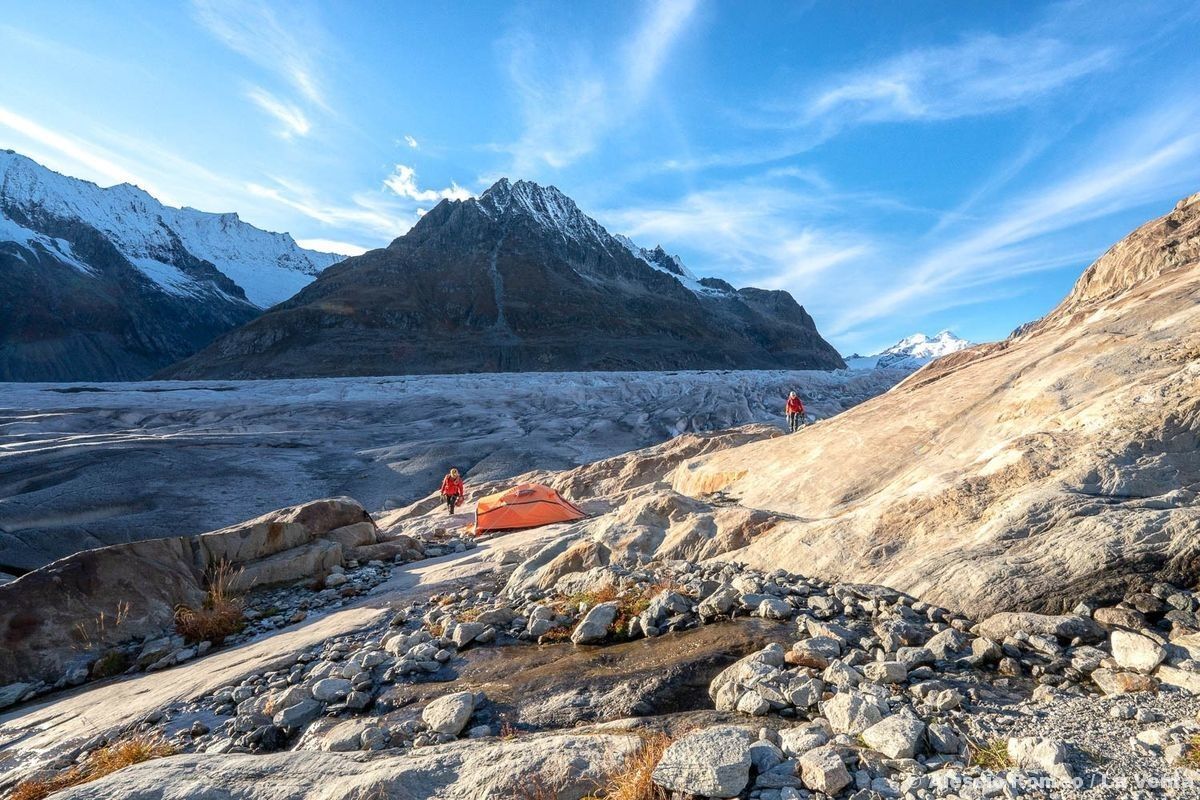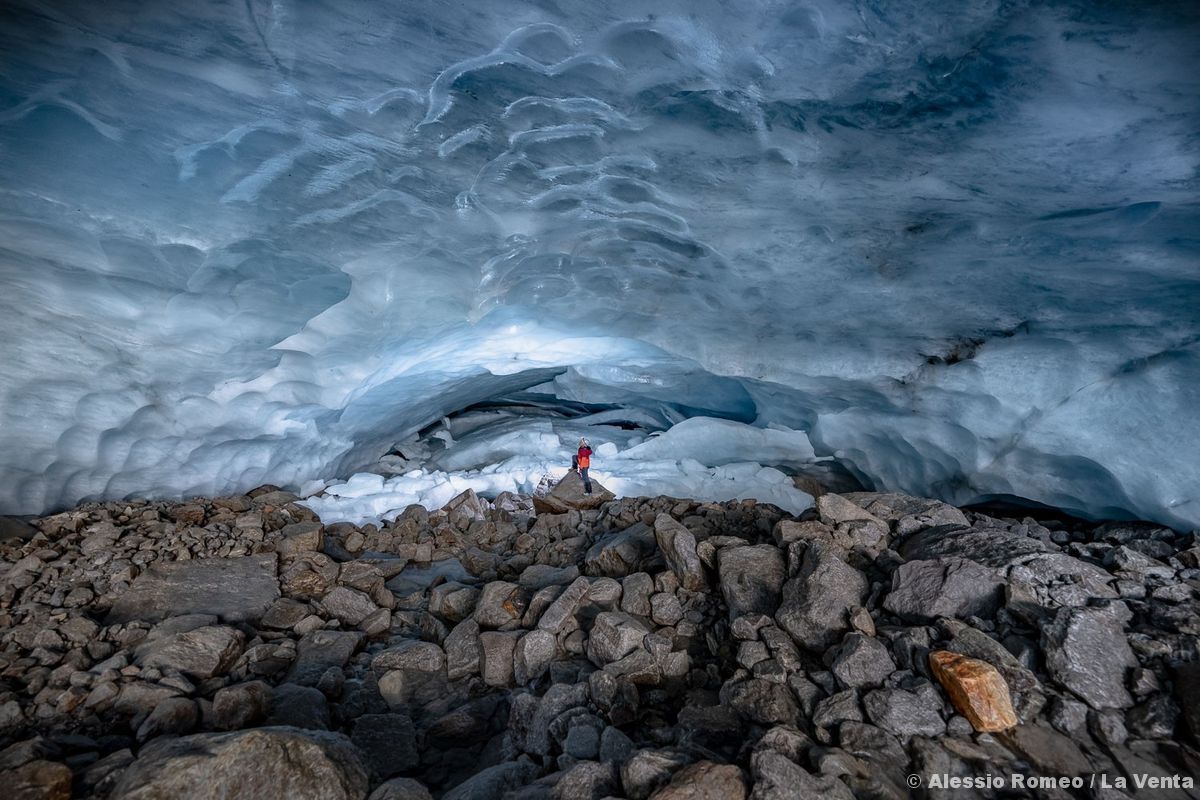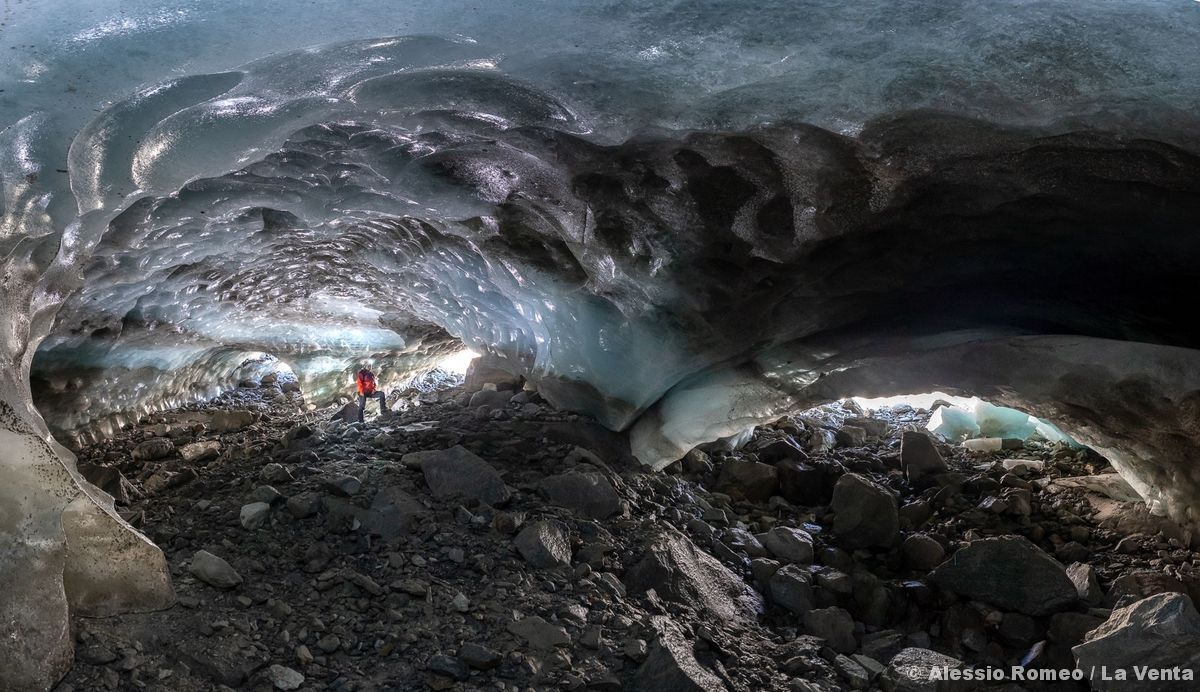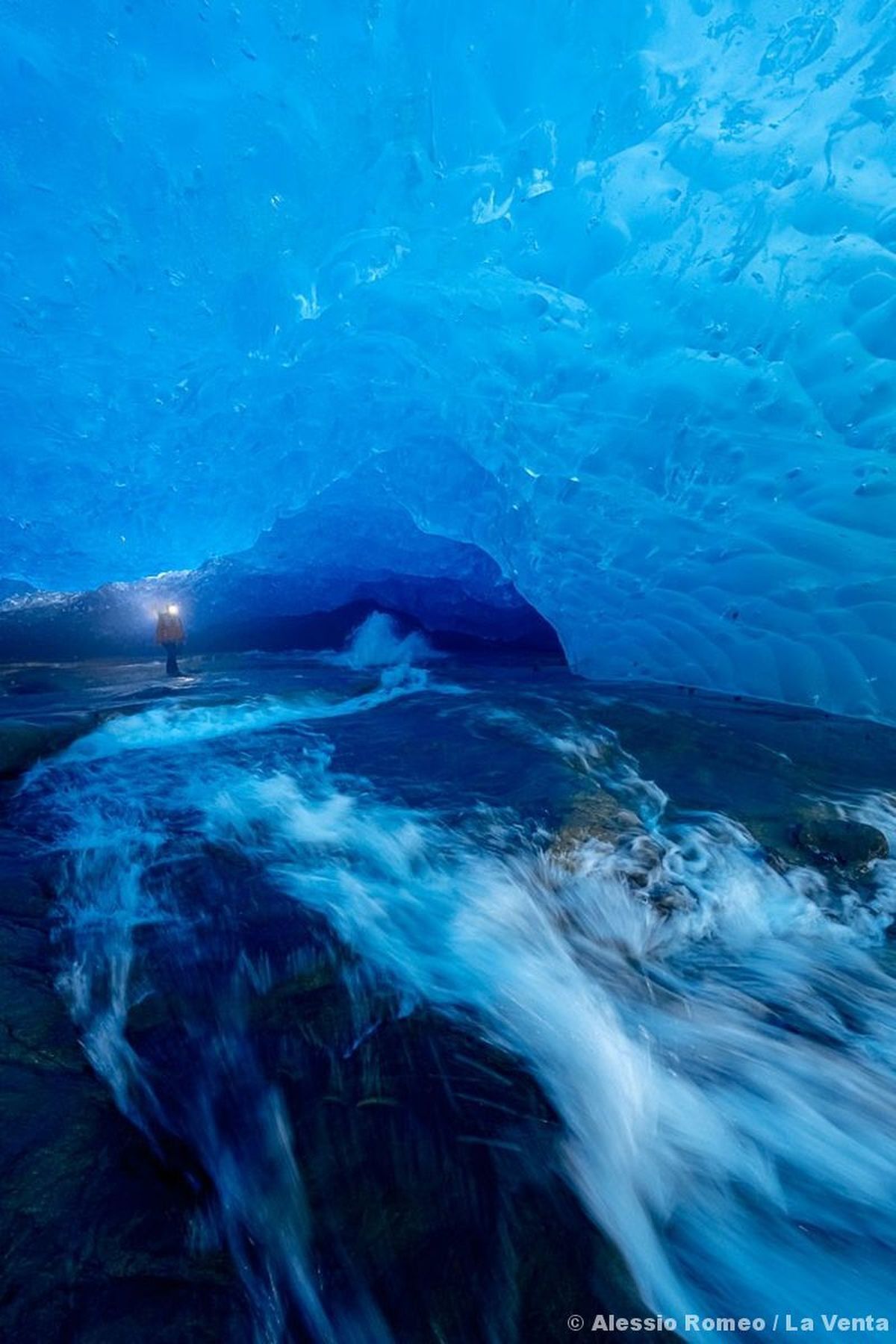
La Venta is a geographical exploration association that has been collaborating with Ferrino for decades. One of the latest expeditions, held in October 2022, saw the glaciologists and speleologists of La Venta and Inside The Glaciers intent on carrying out surveys on the Swiss glaciers of Aletsch and Gorner, to study the glacial masses from within and be able to understand their evolution, in a constant combination of exploration and scientific research.
We tell you about the results of this expedition, with this interview with Alessio Romeo, La Venta member and geologist.
Alessio, what are the main results of your expedition?
On both glaciers, Aletsch and Gorner, we have found the effects of the last torrid summer that has strongly marked all the glaciers of the Alps without sparing these two giants. Many cavities have reported morphological changes due to high melting and therefore enlargement of the hypogeal environments and in some cases the collapse of these structures due to the collapse of the vault.
In your reports you read many notes on contact caves. What are they and why are they important?
Contact caves are natural structures that form between rock substrate and ice.
.
The best known, already explored and represented for some centuries, are those at the front of the glaciers from where the melt waters come out in the warmest months of the year. Then there are cavities at the contact created by the meeting of torrents coming from outside that insinuate themselves under the ice due to the melting power that their waters (at a temperature higher than the melting temperature) have on the ice. These cavities in particular have recently been the object of study by some of us because they represent, in our opinion, an important factor in the reduction of the mass of the glaciers, a phenomenon, moreover, rather invisible to the eyes of those who analyze and quantify the mass balance of the glaciers only through satellite images ...
Quantifying, even approximately, the amount of ice lost in a year beneath the surface will allow us to understand the real impact of these cavities on the glaciers and their future.

What kind of recurring measurements do you operate inside the glaciers? What are the main parameters that you monitor?
Mainly temperatures of both water and air and with constant recurrence also volumes through 3D scans and photogrammetry.
We also collaborate with some professional companies that operate in the field of drones, photogrammetry and high definition 3D surveys with laser scanners.
Among these companies are VIGEA, an Italian company founded by another La Venta partner, Tommaso Santagata, and Flyability, a Swiss company that has developed, thanks also to the collaboration with La Venta itself, a special spherical drone capable of resisting impacts and above all capable of supporting speleologists in the exploration of caves when environmental conditions would make it impossible for a human being to progress or even survive.
With the use of these cutting-edge technologies we are able to obtain three-dimensional models of the cavities in real time, which are very useful in their study and which allow for further implications, such as in the field of virtual reality, where through the use of special viewers, anyone can "visit" otherwise inaccessible places.
The first measurements were made on the Alestch glacier: what did you find?
The three of us set off for Alestch, a day late due to rain, to reach the contact cave of Marjelensee where true blue awaits us, that unique electric blue colour of this spectacular ice cave in the heart of the Alps.
Since 1864, the Swiss weather stations have not recorded temperatures as high as this year in October. An October that has given us abundant rains even at 2400 m above sea level where we hoped they would be of the snow type.
The high external temperatures and the rains have in fact made the torrent, which descends from the slopes of the mountain creating the cave itself, a rushing river, an observation that does not please us, foreseeing difficult water conditions inside the cavity.
Arriving at the entrance, we notice the substantial morphological changes compared to 2021: the collapse of the entrance portal and the notable reduction in its size, as well as the collapse of the glacier at the cave and the consequent lowering of the vault that we can already sense from the outside.
As expected, the water of the stream forcefully enters the main gallery of the cave, ending in a siphon lake a few dozen meters inside it right where usually, with the help of a rope, we reached a rather narrow passage about fifteen meters below (now submerged), a passage that has never been passed (at least not by us) because each time it is impassable due to the stream that enters it... and also for this year, with great disappointment, we do not have the opportunity to explore further. We therefore dedicate ourselves to the topographic survey, especially of the galleries to the right of the portal that have also been present in the last two years but which have equally undergone a notable change, increasing in size and development. The entire cavity is pervaded by a cloud of humidity: nebulized water that sticks to the vaults of the galleries and creates dripping everywhere: this also certainly contributes to the melting process.
The next day we attempt to cross the glacier to explore the diametrically opposite side of the main tongue where the presence of a stream suggests the existence of a cave at the contact. Towards the middle of the walk, where the crevasses become deeper and deeper and perfectly perpendicular to our direction of progression, we decide to return.

And what about the Gorner?
On the Gorner glacier, which has lowered by several meters compared to 2021, we have found some quite notable morphological changes both in the contact caves and in the glacial mills.
Contact Cave 3 (CC3 hereafter), the contact cave which was the objective of our studies, welcomes us with an enormous collapse of the vault in the main gallery right where we had placed one of the sensors which we however managed to recover despite the risk of a further collapse of the ice blades suspended above our heads.
By analyzing the situation better we realized that the collapse, initially thought to be insurmountable, presented a narrow passage between the blocks of ice that allowed us to enter a very large tunnel. The environments turned out to be morphologically very similar to those found in 2021, but with a general lowering of the tunnel.
The exploration allowed us to reach and pass the point where last year the cave ended on a siphon lake, allowing us to continue towards the heart of the glacier. Only by analyzing the topographic survey data will we see that the cave insinuates itself under the glacier for over 400 m, ending, but only for us explorers, in a new semi-flooded passage at a depth of about 160 m from the entrance.
The cave, however, is not limited to a single passage and is revealed to be much more developed than expected with a maze of large lateral galleries, all unexplored and connected to each other, which have dimensions much larger than the main one. In total, approximately 950 m of development will be detected without considering the highly unstable portions of the cave. To be on the safe side, we have not explored.
English: The last day the activities involved the exploration of a glacial mill, a shaft about twenty meters deep, located on what remains of the residual tongue of the glacier, and which ends on the rocky substrate at the base of the glacier itself, where countless collapses prevent us from continuing and following the flows of the stream that feeds it. This mill had already been descended by Alessio, one of our members, over 20 years ago, during his thesis work: at the time, it had more or less the same depth and became impenetrable due to a narrow passage in the ice. At the time, still in the center of this tongue that had much larger dimensions, there was a mill called G10 about 60 m deep (year 2000) and this also did not reach the rocky substrate. This says a lot about how much thickness of ice has been lost in recent years and how little time remains for this mass of ice before the rocky substrate reached this year at the base of the mill is brought to light.
Also during the last day, the Contact Cave Gornersee (CCG) was explored, which is formed every year by the presence of a stream that descends from the lake located under the Rosa Hutte refuge. The entrance portal this year was very large and the surrounding area was characterized by the presence of large blocks of ice that in reality testify to the formation of a temporary lake between the glacier and the rock of which these large "icebergs" delimit the edges... A photo found on the web later confirmed this hypothesis.
In this area, a huge lake called Gornersee used to form, which took shape in spring, accumulated thousands of cubic meters of water that then, towards the middle of July, disappeared towards the valley in just 3 days through hidden paths. In the past, this phenomenon created many problems for Zermatt and the valley populations, now there are canalization systems that limit the damage. Since 2010, there has been no news of this lake, but who knows, it might reappear in the future?
A few years ago Zermatt did suffer from flooding during the summer, but it was not clear where the water came from.
While this mystery remains unsolved for the moment, we will try to enhance our efforts to use data and measurements collected in recent years in order to quantify the impact that the caves on contact have on the mass balance of the glaciers, in the meantime another year will pass before we see these suffering giants and their changes again and this "snapshot" of ours relating to the state of the glaciers in October 2022 cannot be repeated, but anyone who wants can make a different one using ours as a comparison.
Between the measurements taken in August, the continuous monitoring of external and internal temperatures, the 3D surveys carried out in the last two years by VIGEA and Flyability, we really have a huge amount of data that will now have to be compared and analyzed for future scientific publications.

Returning to a glacier is a bit like going to visit an elderly grandfather who lives far away. You realize that he is slowly fading away and you don't know how much longer he will be with you. You are happy, excited, but at the same time a melancholy accompanies you.
In recent years we often return to the same glaciers and this is the feeling that comes over us every time... we see these old grandparents disappearing ever more quickly and we are aware that this process is not reversible at the moment!
